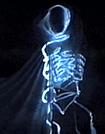

Wireframe costume in VRML
designer: Michael Oberle
After two years of concept and design work, production director Cheryl Faver and GSRT staff are working to refine the digital mobile projection system and apply it to a live production of Gertrude Stein's The Silent Scream of Martha Hersland, which Faver has adapted for the "virtual" stage from the novelist's Making of Americans. Incorporating a new range of aesthetic tools and effects, images of remote actors (senders) will be overlaid on actors in the local space (receivers) to create new repertoires of characters, visual metaphors and choreography.
During the coming year, a final series of technical and performance workshops will focus on hardware and software solutions for digital mobile projection. Through the system, characters and sets will be:
- Communicated over digital networks from remote locations via cameras, or created by computer-generated animation and modeling techniques.
- Shaped through the use of middle ware, which manipulates the image as it is relayed from camera or computer to projector.
- Projected into the performance space using a system of mobile projectors whose movement can be tightly coordinated with live, moving forms on the stage.
- Moving a projected digital video image across the stage in sync with a performer's choreographed movements
- Coordinating projected images and performers with mobile projection units, cameras and monitors
- Developing practical equipment and systems for digitizing and keying projected images
- Synchronizing other digital media/stage components (e.g., virtual sets, animation, lighting) with performances

Workshop experiment:
Drawing on projected tablet

Workshop experiment:
dynamic lighting control
The extended development process offers us the opportunity to develop individual scenes in conjunction with successive generations of digital tools and equipment. We anticipate that each workshop will reveal further problems and challenges. As the team works toward a desired artistic end, we will be able to modify and expand conceptions of the potential dramatic effect of the tool - then apply it to a live performance. In other words, as the tool shapes the product, the product shapes the tool. The ultimate beneficiaries are, of course, audience members who will be able to experience expanded visual and dramatic encounters in the arts.
- projects
- education & dramaturgy
- iniatives
